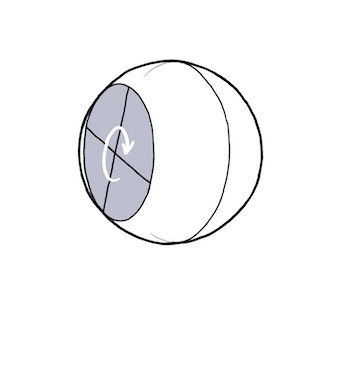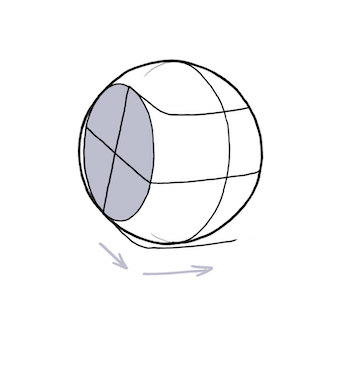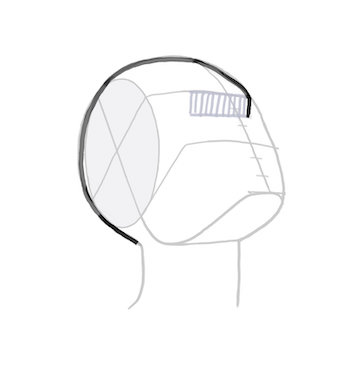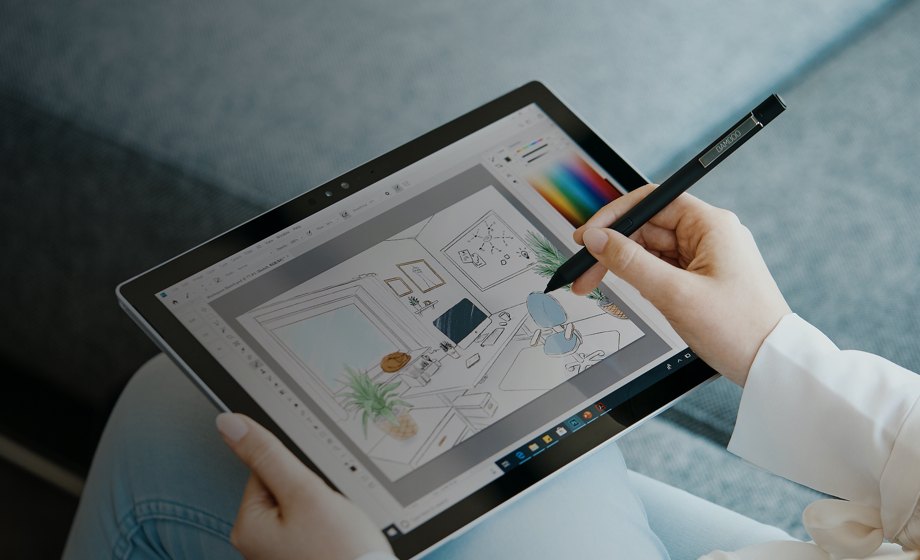Tavolette con penna
Puoi creare bozzetti, disegnare e modificare immagini con un pad reattivo e una penna precisa mentre vedi le tue creazioni prendere vita sullo schermo.

Questo è il primo di alcuni tutorial. Nel primo episodio vedremo come disegnare una testa.
Prima di parlare di dettagli come occhi, naso, ecc. ci concentreremo sulla forma della testa. Questo episodio è un ottimo punto di partenza se sei un principiante e vuoi capire come disegnare una testa e i relativi dettagli esplorandoli da diverse angolazioni. Anche gli artisti più avanzati scopriranno alcuni ottimi trucchi su come trovare le proporzioni e le prospettive giuste. Iniziamo!


Prima di tutto, probabilmente te lo aspetterai se hai già seguito altri tutorial, iniziamo con un cerchio. Il cerchio rappresenta ovviamente una sfera. Sembra un cerchio solo perché disegniamo in due dimensioni.
È una delle forme più usate per disegnare elementi organici. Dai un'occhiata ai tutorial precedenti, ad esempio Come disegnare un cane, per vedere un altro esempio in cui si usa il cerchio.

Dalla sfera tagliamo via due fette, una su ogni lato.
Immagina una mela. Tagliando via una fetta della mela si ottiene una forma ellittica. Lo stesso avviene con la nostra area tagliata. Noterai che il metodo della sfera o del cerchio è usato anche qui e che lo modifichiamo per adattarlo alla forma base della testa.
Un'altra cosa da ricordare è, che se guardi la testa dall'alto, i nostri due tagli non sono esattamente paralleli, ma si restringono leggermente verso il naso. Ecco perché quando guardiamo il viso frontalmente vediamo le due aree ellittiche.
L'altezza dei tagli dovrebbe corrispondere a circa due terzi dell'intera sfera.

La prossima cosa che ci serve è una croce su ogni area tagliata su entrambi i lati. Sarà importante soprattutto in seguito, quando inizieremo a ruotare la testa. Le croci fungeranno da guida per creare la prospettiva desiderata, indipendentemente dall'angolazione della testa.
Ci serve inoltre una linea centrale per la simmetria. Anche questa fungerà da guida quando inizieremo ad aggiungere i dettagli essenziali della testa.
Ora dovremmo collegare i bordi delle nostre aree tagliate per ottenere un paio di suddivisioni.
Per ottenere l'altezza finale del viso dobbiamo solo aggiungere un'altra suddivisione qui in basso. Ora abbiamo le linee guida principali per il volto. A questo punto vediamo quali sono i diversi modi in cui possiamo usarle.

La linea superiore è quella dei capelli. È la linea da cui hanno origine i capelli. Sempre che ci siano dei capelli! Ma, anche se stai disegnando una testa pelata, è utile tenere in considerazione la linea dei capelli per trovare le proporzioni fra i dettagli della testa. Un esempio di questo è la seconda linea. È più o meno la linea su cui dovrebbero trovarsi le sopracciglia.
La terza linea è quella del naso. Nello specifico, è la parte inferiore del naso. E l'ultima linea guida è quella del mento. Dovremmo impostare il mento a questa altezza.
A proposito: ogni viso è diverso. Anche la distanza fra le quattro linee guida tende a variare da un volto all'altro. In rarissimi casi, le distanze potrebbero essere tutte uguali. Prova a sperimentare con le distanze. Puoi portare l'esperimento all'estremo, se vuoi. I menti giganteschi fanno sempre ridere! In questo tutorial però ci atteniamo alle basi.

Ora posso iniziare dal punto più basso delle aree tagliate. Non preoccuparti di trovare un punto esatto nella parte inferiore delle aree tagliate, perché in realtà possiamo iniziare leggermente al di sotto, a seconda di quanto vogliamo che la mascella sia pronunciata. In seguito, collegala al mento. Ed ecco già disegnata l'intera forma della testa! Tieni presente che le prime linee guida che abbiamo usato aiutano a controllare le proporzioni. In base alle linee guida, possiamo decidere ad esempio quanto è pronunciata la linea della mascella, quanto è grande il mento e così via.


Ruotiamo leggermente la testa a destra per vedere come costruire il profilo. Con la testa ruotata a destra, vediamo solo una delle aree tagliate, che appare più grande di prima. La linea centrale non è più una linea retta. Forma invece un'ellisse.

Dal punto che si trova sulla linea delle sopracciglia non seguiamo più la sfera. Andiamo invece più o meno dritti verso il basso. Ricorda: la testa è ruotata a destra, quindi andare dritti verso il basso si riferisce solo alle nostre azioni, non alla figura stessa.
Per creare un mento più morbido e femminile, puoi tenerti leggermente all'interno della linea centrale. Se vuoi creare un mento più squadrato e tipicamente maschile, vai più dritto o allontanati leggermente.

Possiamo generare di nuovo le nostre tre aree per poter definire la linea del mento. Infine, collega il mento alla mascella. Ed ecco qui: la forma completa.


Guardiamo una vista di profilo. L'area tagliata appare come un cerchio perfetto. Vediamo un cerchio perfetto, non perché sia la forma naturale del lato del viso. Possiamo considerarlo come una linea guida per osservare i dettagli della sfera-testa dal lato.

La linea centrale si sposterà verso il bordo del viso. E possiamo disegnare di nuovo le tre linee guida. E poi una in più per il mento. A questo punto siamo abituati a vedere questa linea del mento, anche da varie angolazioni.

Basta collegare il mento alla mascella come abbiamo fatto prima con una linea che va dritta verso il basso dall'area tagliata. Questo crea un collegamento elegante con il mento. E ora la nostra vista di profilo è completa. Non preoccuparti se a questo punto sembra un casco da rugby. Ricorda che stiamo creando una forma e che questo fa parte del processo di creazione di una testa umana completa.


Passiamo a una prospettiva leggermente più complicata. Ruota la testa a destra e verso il basso. La nostra sfera rimane sempre la stessa: non importa dove la ruotiamo; una sfera sarà sempre una sfera. E lo stesso vale per le aree tagliate. In fin dei conti, queste sono lì solo per facci sapere che la testa è ruotata a destra. Per orientare la testa verso il basso, dobbiamo solo ruotare questa croce.
Ora che la croce è ruotata verso il basso, non cambia solo la linea orizzontale, ma anche quella verticale.

Per disegnare le linee guida, immagina un angolo che stia fra la parte anteriore e quella laterale della testa. Per capire dove si trova, tocca il bordo esterno del tuo sopracciglio.
Ovviamente, alla fine non sarà proprio un angolo, ma piuttosto una curva, perché non ci sono angoli netti su un viso. Possiamo quindi ammorbidire subito questo angolo.

Per proseguire la linea centrale dalla linea delle sopracciglia, basta procedere in parallelo alla linea verticale che incrocia l'area tagliata. Ora la linea centrale non va più dritta verso il basso. In realtà è leggermente inclinata a sinistra, perché abbiamo ruotato la testa verso il basso e a destra. Tieni presente che stiamo guardando questa testa da sopra l'orecchio sinistro.

Fai molta attenzione alla linea del mento: è un po 'più corta sul lato destro rispetto al sinistro perché la testa è ruotata a destra. Sul lato sinistro vedremo quindi una parte maggiore del mento. Da questa prospettiva il lato destro del mento è nascosto dal resto della testa.

Collega le linee come abbiamo fatto in precedenza.


Passiamo a una prospettiva leggermente più complicata. Ruota la testa a destra e verso il basso. La nostra sfera rimane sempre la stessa: non importa dove la ruotiamo; una sfera sarà sempre una sfera. E lo stesso vale per le aree tagliate. In fin dei conti, queste sono lì solo per facci sapere che la testa è ruotata a destra. Per orientare la testa verso il basso, dobbiamo solo ruotare questa croce.
Ora che la croce è ruotata verso il basso, non cambia solo la linea orizzontale, ma anche quella verticale.

Per disegnare le linee guida, immagina un angolo che stia fra la parte anteriore e quella laterale della testa. Per capire dove si trova, tocca il bordo esterno del tuo sopracciglio.
Ovviamente, alla fine non sarà proprio un angolo, ma piuttosto una curva, perché non ci sono angoli netti su un viso. Possiamo quindi ammorbidire subito questo angolo.

Per proseguire la linea centrale dalla linea delle sopracciglia, basta procedere in parallelo alla linea verticale che incrocia l'area tagliata. Ora la linea centrale non va più dritta verso il basso. In realtà è leggermente inclinata a sinistra, perché abbiamo ruotato la testa verso il basso e a destra. Tieni presente che stiamo guardando questa testa da sopra l'orecchio sinistro.

Fai molta attenzione alla linea del mento: è un po 'più corta sul lato destro rispetto al sinistro perché la testa è ruotata a destra. Sul lato sinistro vedremo quindi una parte maggiore del mento. Da questa prospettiva il lato destro del mento è nascosto dal resto della testa.

Collega le linee come abbiamo fatto in precedenza.


Passiamo a una prospettiva leggermente più complicata. Ruota la testa a destra e verso il basso. La nostra sfera rimane sempre la stessa: non importa dove la ruotiamo; una sfera sarà sempre una sfera. E lo stesso vale per le aree tagliate. In fin dei conti, queste sono lì solo per facci sapere che la testa è ruotata a destra. Per orientare la testa verso il basso, dobbiamo solo ruotare questa croce.
Ora che la croce è ruotata verso il basso, non cambia solo la linea orizzontale, ma anche quella verticale.

Per disegnare le linee guida, immagina un angolo che stia fra la parte anteriore e quella laterale della testa. Per capire dove si trova, tocca il bordo esterno del tuo sopracciglio.
Ovviamente, alla fine non sarà proprio un angolo, ma piuttosto una curva, perché non ci sono angoli netti su un viso. Possiamo quindi ammorbidire subito questo angolo.

Per proseguire la linea centrale dalla linea delle sopracciglia, basta procedere in parallelo alla linea verticale che incrocia l'area tagliata. Ora la linea centrale non va più dritta verso il basso. In realtà è leggermente inclinata a sinistra, perché abbiamo ruotato la testa verso il basso e a destra. Tieni presente che stiamo guardando questa testa da sopra l'orecchio sinistro.

Fai molta attenzione alla linea del mento: è un po 'più corta sul lato destro rispetto al sinistro perché la testa è ruotata a destra. Sul lato sinistro vedremo quindi una parte maggiore del mento. Da questa prospettiva il lato destro del mento è nascosto dal resto della testa.

Collega le linee come abbiamo fatto in precedenza.

Ora, per la vista dal basso: con questa linea delle sopracciglia accade il contrario, perché ora il piano sotto le sopracciglia è visibile in misura molto maggiore. Per questo motivo tracciamo la linea a valle delle sopracciglia molto più lunga.

Ed ecco che anche con l'orecchio succede qualcosa di nuovo, perché se seguissimo queste linee guida come prima, l'orecchio finirebbe per sembrare dipinto su una testa priva di orecchie. È un problema di prospettiva: l'orecchio non è piatto rispetto alla testa. Anzi, sporge un po' dalla testa. È per questo che in prospettiva l'orecchio risulta un po' sopra la linea guida.

Questo è praticamente tutto per quanto riguarda il modo di disegnare la forma di una testa. Ovviamente la si può disegnare da tante altre prospettive. Ma queste quattro prospettive mostrano l'intero procedimento in modo abbastanza completo. Spero di averti fornito una buona panoramica di questo metodo per costruire la forma di una testa. A presto con il prossimo episodio della serie. Buon disegno!

Puoi creare bozzetti, disegnare e modificare immagini con un pad reattivo e una penna precisa mentre vedi le tue creazioni prendere vita sullo schermo.

Disegna, progetta e crea con una penna precisa direttamente su uno schermo ad alta risoluzione.

Scrivi con la penna sulla carta e converti in digitale i tuoi appunti manuali.

Scrivi e metti nero su bianco le tue idee sul tuo dispositivo mobile con una penna digitale Wacom.
L’idea di Wacom è quella di avvicinare persone e tecnologia attraverso tecnologie naturali. È questo che l'ha resa leader al mondo nella produzione di tavolette con penna e display interattivi, penne digitali e soluzioni per il salvataggio e l'elaborazione di firme digitali. La tecnologia all’avanguardia dei dispositivi Wacom è stata utilizzata per creare alcune delle più emozionanti opere d’arte digitali, film, effetti speciali, moda e design del mondo. La sua tecnologia ad altissimi livelli consente sia ad aziende che a privati di esprimere la propria personalità. Fondata nel 1983, Wacom è un’azienda internazionale con sede in Giappone (Tokyo Stock Exchange: 6727) e uffici in tutto il mondo a supporto del marketing e della distribuzione in oltre 150 paesi.